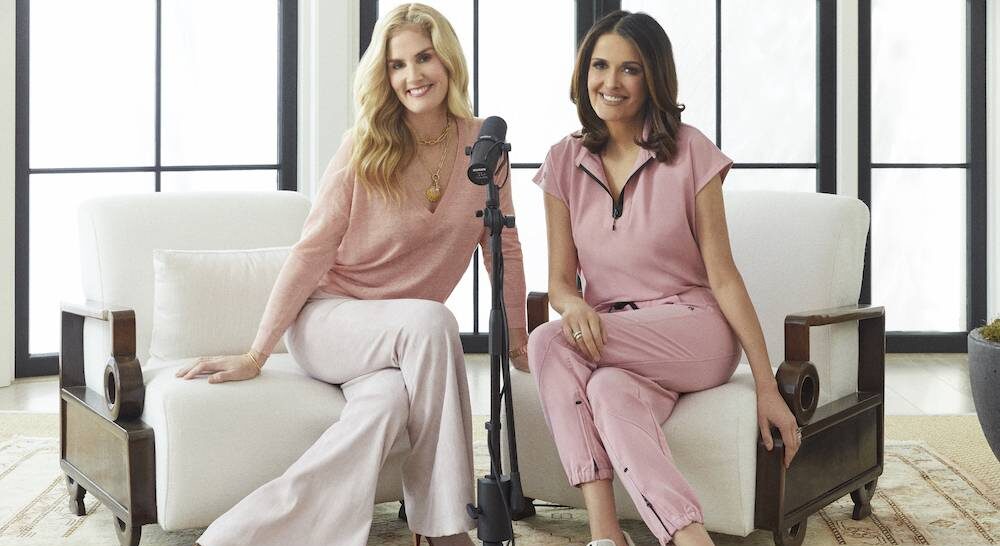Beauty...

By Mollysims.com
Dr. Thaïs Aliabadi and Mary Alice Haney return to the Lipstick on the Rim studio to discuss the launch of their new SHEMD Breast Cancer Risk Calculator. The duo delve into the next steps and action plans every woman should follow after receiving their Breast Cancer Risk score, the importance of genetic testing in breast cancer prevention, and Dr. Aliabadi shares her experience with medical gaslighting, even as a top OB/GYN. We hope this episode provides further education and motivation for women all over the globe to continue advocating for their health and well-being.
“Mammograms are the standard of care for breast cancer screening. They’re very good. They’re the number one modality that we use to diagnose breast cancer. They catch 4 out of 5 cancers. So every time you do a mammogram, you have a four out of five chance that you’re going to catch a cancer or a lesion. The problem is that 50% of women walk around with dense breast tissue. The density of the breast doesn’t come by you touching your breast and feeling it. It’s a mammographic or imaging finding. So you have to look at your mammogram result and/or the MRI results of the breast, and the radiologist’s comments about your breast density. If you have dense breast tissue and you do a 2D mammogram, you might as well not do that mammogram. 2D mammograms are just x-rays of your breast. Dense areas look white on the screen so it’s hard to see any lesions. Often, women with dense breasts do a 2D mammogram, and they get a call saying their mammogram’s normal, and that’s the end of it. If you do your mammogram, make sure you ask your technician, your doctor, or anyone, to get the report. You can also ask for a 3D mammogram. With a 3D mammogram, we get an image of the entire breast. The radiologist is more likely to see a lesion on a 3D mammogram than a 2D mammogram in patients with dense breast tissue. Breast ultrasounds are also great for women with dense breasts. ”
“When you get a double mastectomy, what’s important is that you pick a surgeon that will pick your health over vanity. During a double mastectomy, the surgeon goes in, they make a big incision, and they basically carve out all the breast tissue right under your skin and nipple, and remove it. Even in the best hands, they leave less than 5 percent of that breast tissue behind. Breast tissue can go all the way up to our clavicle or our armpits, so it’s hard to take 100 percent of it out, however, you want them to take out about 95 percent of it. In my case, two weeks after my surgery, with my breasts completely inflamed, I was looking in the mirror and felt like I had breast tissue in my chest. My husband said, ‘There’s no way, you were under the knife for 10 hours.’ I’m like, I understand, but I feel like I have breast tissue. I called my doctor and asked if she took all of my breast tissue out and she said ‘Of course but you know we can’t take 100 percent of it out. We take about 95%, we leave 5%.’ I’m a gynecologist, I understand, but this is not 5%. This is a lot of breast tissue left. I put myself in an MRI machine two weeks after my double mastectomy. The radiologist came, and she’s like, you don’t have anything. I say I’m really sorry, but you understand that, they also missed my cancer, so I have a hard time trusting people at this point. I’m traumatized. I want a second opinion, then a third. Turns out I had about 35% of my breast tissue left. I got a second double mastectomy. Look what I had to go through as a physician, as a woman’s health advocate.”
“On our site, there is a Lifetime Risk Calculator that calculates your chances of having breast cancer. You need to understand what to do when you get your number, that’s why in addition to this calculator, there are action plans with videos for every single stage. When you do your lifetime risk, you get a percentage. If that percentage is less than 15%, you fall into the low risk category. If your risk falls from 15 to 20%, you’re in the intermediate category, 20% or more, you fall into the high-risk category. What does that mean? It means that instead of starting your breast imaging at 40, you can push it all the way up to 30. Insurance companies will pay for you to do your breast imaging. And usually, I start with a mammogram and ultrasound, and you can definitely consider adding an MRI in the high risk category. There’s also a very high risk category in my practice. I made that up. That’s the Aliabadi very high-risk category. I consider that 35% and above. I feel it’s important that anyone with 35% and above wakes up. There’s also genetic testing. The best available genetic test right now is the MyRisk Hereditary Cancer Test by Myriad. It’s a diagnostic test that checks for 48 cancer causing genes. Not all of them are breast cancer, but at least, maybe 20 or 21 of them are breast cancer related. So when you do the Myriad test, you can do it with sputum or blood at your doctor’s office, and you get a report back with three rows of information, from whether or not you carried one of those 48 cancer causing gene to your risk score (which isn’t standard care, but it’s helpful), and more. Again, it’s not just getting your results, but doing something with them, taking the next step.”